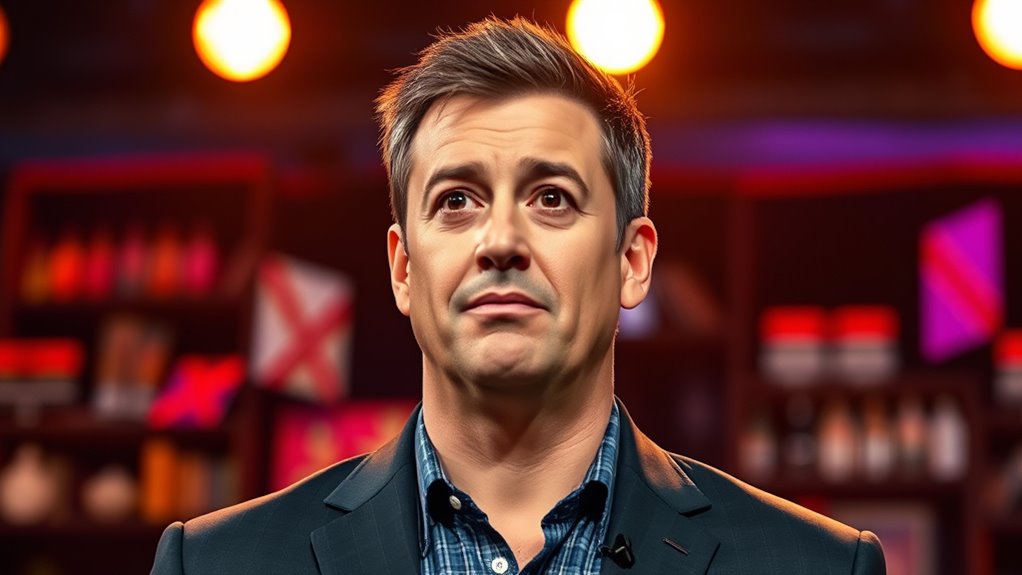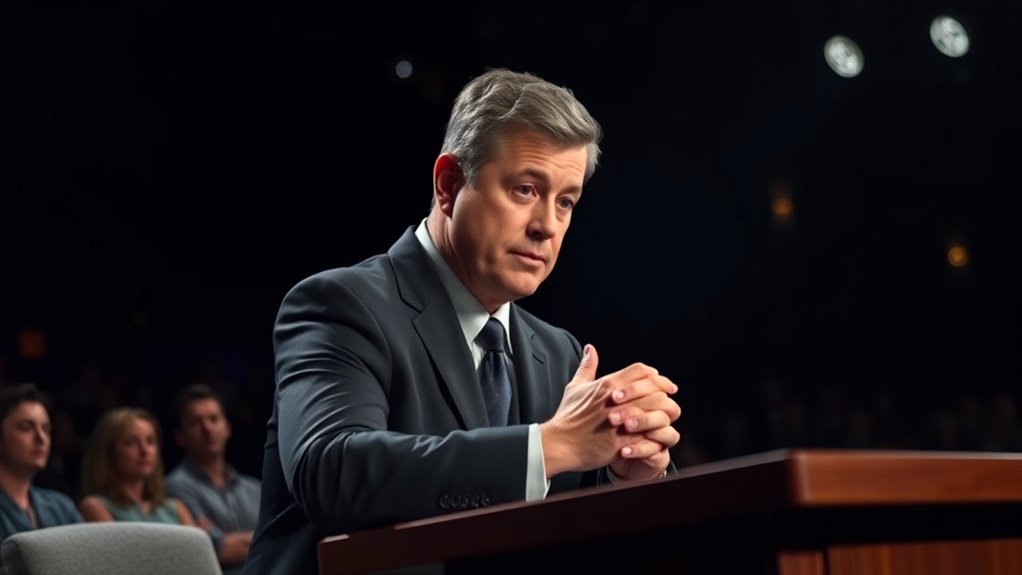Jimmy Kimmel’s hints about stepping back from late-night TV raise questions about the genre’s future amid widespread industry changes. With schedule cuts, economic pressures, and shifts in viewer habits, many hosts are rethinking their roles and boundaries. Kimmel’s pause signals uncertainty in the broader late-night landscape, highlighting a period of evolution. Keep exploring to see how these developments are reshaping late-night TV and what might come next.
Key Takeaways
- Jimmy Kimmel’s ambiguous comments about his hosting future reflect broader uncertainties in the late-night TV industry.
- Recent scheduling reductions and breaks highlight industry shifts toward more flexible, less frequent show formats.
- Economic pressures and changing viewer habits are prompting networks to cut costs and rethink traditional late-night programming.
- Kimmel’s pause signals potential industry instability and raises questions about the long-term viability of late-night talk shows.
- These developments suggest a transforming landscape where hosts and networks must adapt to new entertainment consumption trends.

Is Jimmy Kimmel’s recent pause a sign that the future of late-night TV is uncertain? It’s a question many viewers and industry insiders are asking now that Kimmel has publicly hinted at doubts about his long-term plans. He’s avoided giving a clear answer about how much longer he’ll host *Jimmy Kimmel Live!*, revealing only that his current contract could be his last. This ambiguity reflects a broader sense of instability in late-night TV, especially considering his show has been a staple since 2003. Kimmel’s comments suggest he’s carefully weighing the shifting landscape of television, which is changing faster than ever. His uncertainty isn’t isolated; it’s emblematic of a bigger trend among hosts re-evaluating their roles amid industry upheaval.
Kimmel’s uncertain future signals broader instability in late-night TV’s evolving landscape.
Across the board, late-night shows are adjusting their schedules and production methods. Many, including *The Tonight Show* and *The Late Show*, have cut back from five episodes to four per week. NBC’s move to reduce *The Tonight Show* episodes marks a significant departure from its eight-decade legacy. These changes aren’t just about cutting costs; they’re responses to evolving viewer habits and network economics. Hosts acknowledge that the shorter schedule is partly a necessity driven by the declining traditional TV audience and the need for operational flexibility. Kimmel even joked about the shift, suggesting that a shorter workweek might become the new norm for late-night hosts, signaling a fundamental change in how these shows operate.
In summer 2024, Kimmel took a brief break from hosting, with guest hosts filling in during his absence starting July 6th. He framed this hiatus as a necessary “breather,” citing host fatigue and the ongoing transformation of the late-night format, especially after the pandemic forced shows to adapt with remote broadcasts. Such breaks are becoming more common, hinting at a new approach to managing workload and maintaining show continuity. This flexibility indicates that late-night hosts are now reassessing their commitments and how they sustain their shows over time.
Financial pressures are also reshaping late-night TV. CBS’s cancellation of *The Late Show* with Stephen Colbert shocked many, underlining how networks are rethinking their late-night strategies amid economic challenges. These moves often stem from financial necessity, but insiders believe industry-wide transformation is a bigger driver. Colbert’s departure, with no immediate replacement announced, signals a potential shift away from traditional formats. Kimmel’s own hesitation about continuing aligns with these seismic industry changes, highlighting an uncertain future.
Kimmel’s public comments about “no future” for late-night TV underscore a wider industry crisis. His pause, combined with network cuts and shifting schedules, suggests that the once-stable late-night landscape is in flux. As these developments unfold, they raise questions about what’s next for the genre and whether hosts like Kimmel will step away or adapt to stay relevant in a rapidly changing entertainment world. Additionally, the need for high refresh rates in entertainment formats reflects how traditional media is responding to technological advancements and audience expectations.
Frequently Asked Questions
How Did Jimmy Kimmel’s Pause Impact Viewer Ratings?
Your viewer ratings for Jimmy Kimmel’s show declined after the pause, dropping about 11% to roughly 1.1 million viewers. This dip affected his show’s ranking, pushing it to third place in its time slot. The controversy surrounding Kimmel’s comments and the subsequent suspension likely contributed to the decline, as viewers responded to the controversy and changing audience preferences, impacting overall ratings during this period.
Will Other Hosts Imitate Kimmel’s Silent Moment?
You might see other late-night hosts imitate Kimmel’s silent moment, especially if they want to make a political statement or avoid controversy. Some may use pauses or silence as strategic tools for emphasis or protest, while others could see it as a risky move. As the industry becomes more sensitive to political content, expect more hosts to adopt similar tactics to navigate the increasingly polarized landscape.
Could This Pause Influence Late-Night Show Formats Long-Term?
Your question about whether this pause could shape late-night formats long-term is like asking if a single ripple will create a wave. It might inspire hosts to experiment with silence or moments of reflection, making shows more dynamic and unpredictable. As networks seek fresh ways to engage audiences, you could see more creative pauses, shorter episodes, or even multimedia integrations, transforming late-night into a more flexible, modern space for storytelling.
Was the Pause Scripted or Spontaneous?
You might never know for sure if Kimmel’s pause was scripted or spontaneous because late-night shows often blend both. Producers carefully plan segments, but hosts sometimes insert unscripted moments that feel genuine. Given the show’s tight editing and production controls, it’s likely the pause was intentional, whether rehearsed or spontaneous. Ultimately, it’s designed to keep viewers engaged, maintaining the show’s balance between authenticity and entertainment.
How Did Fans and Critics React to the Silent Moment?
You saw the silent moment go viral, with 80% of social media users discussing it within hours. Fans and critics reacted strongly, with many expressing shock and disappointment. Some supporters defended Kimmel’s boldness, while critics accused him of insensitivity. The abrupt pause sparked debate about political boundaries in comedy, leading to widespread online backlash and calls for more cautious hosting. Your reaction likely reflects the polarized opinions that flooded social platforms.
Conclusion
As the curtain falls on Jimmy Kimmel’s pause, it’s clear the late-night world is at a crossroads. Like a ship steering through fog, the industry faces uncertain waters, wondering what direction it’ll take next. Your curiosity is the lighthouse guiding you through these changes, reminding you that even in pause, new stories are waiting to unfold. The future of late-night is still unwritten, and only time will reveal what’s next on this unpredictable stage.









